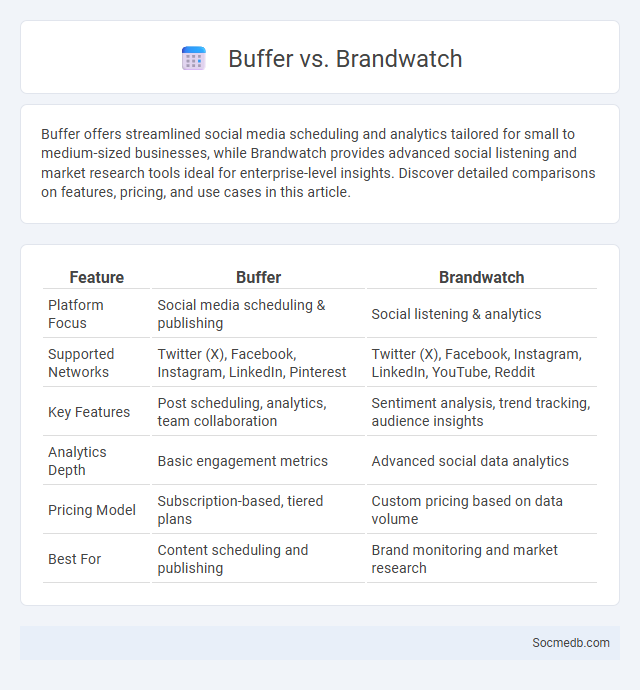
Photo illustration: Buffer vs Brandwatch
Buffer offers streamlined social media scheduling and analytics tailored for small to medium-sized businesses, while Brandwatch provides advanced social listening and market research tools ideal for enterprise-level insights. Discover detailed comparisons on features, pricing, and use cases in this article.
Table of Comparison
| Feature | Buffer | Brandwatch |
|---|---|---|
| Platform Focus | Social media scheduling & publishing | Social listening & analytics |
| Supported Networks | Twitter (X), Facebook, Instagram, LinkedIn, Pinterest | Twitter (X), Facebook, Instagram, LinkedIn, YouTube, Reddit |
| Key Features | Post scheduling, analytics, team collaboration | Sentiment analysis, trend tracking, audience insights |
| Analytics Depth | Basic engagement metrics | Advanced social data analytics |
| Pricing Model | Subscription-based, tiered plans | Custom pricing based on data volume |
| Best For | Content scheduling and publishing | Brand monitoring and market research |
Introduction to Social Listening Tools
Social listening tools analyze online conversations and social media platforms to track brand mentions, customer sentiment, and trending topics. These tools utilize natural language processing and AI to categorize data, enabling businesses to respond promptly to feedback and improve customer engagement. Effective use of social listening supports reputation management, competitive analysis, and market research strategies.
Overview of Buffer, Brandwatch, and Social Listening Platforms
Buffer offers intuitive social media scheduling and analytics, enabling brands to publish content across multiple platforms efficiently while tracking engagement metrics to optimize performance. Brandwatch specializes in advanced social listening and consumer insights, leveraging AI to analyze vast volumes of online conversations and uncover trends, sentiment, and brand perception in real time. Social listening platforms combine data aggregation, sentiment analysis, and competitive benchmarking to provide actionable intelligence for marketing strategies and customer experience enhancement.
Key Features Comparison
Social media platforms differ significantly in their key features, such as user engagement tools, content sharing formats, and privacy settings, which influence how users interact and share information. Visual-centric platforms like Instagram emphasize image and video sharing, while Twitter focuses on short, real-time updates, and LinkedIn prioritizes professional networking and career development. Understanding these distinct features helps you select the best platform aligned with your communication needs and target audience.
Ease of Use and User Interface
Social media platforms prioritize ease of use by offering intuitive navigation, simplified content creation tools, and seamless integration with mobile devices. User interfaces are designed with clean layouts, customizable features, and responsive design to enhance user engagement and accessibility. These elements combine to provide a smooth and enjoyable experience, encouraging frequent interaction and prolonged use.
Social Channel Integrations
Social channel integrations streamline marketing efforts by connecting various platforms such as Facebook, Instagram, Twitter, and LinkedIn into a centralized dashboard. This integration enables real-time content scheduling, analytics tracking, and audience engagement monitoring across multiple social networks. Enhanced data synchronization from social channel integrations drives targeted campaigns, improves customer insights, and boosts overall digital marketing ROI.
Analytics and Reporting Capabilities
Social media analytics and reporting capabilities enable you to track engagement metrics, audience demographics, and content performance in real-time, providing valuable insights for data-driven decision-making. Advanced tools offer customizable dashboards and automated reports that streamline monitoring of key performance indicators (KPIs) such as reach, impressions, and conversion rates. Leveraging these analytics enhances your ability to optimize campaigns, improve targeting, and maximize return on investment (ROI).
Pricing and Subscription Options
Social media platforms offer a range of pricing and subscription options tailored to different user needs, including free basic accounts with advertising-supported content and premium subscriptions that provide ad-free experiences, advanced analytics, and exclusive features. Subscription tiers often vary in cost based on the level of access, such as LinkedIn Premium starting at $29.99 per month or YouTube Premium at $11.99 per month, catering to professionals, creators, and power users. Many platforms also incorporate freemium models, allowing users to upgrade for benefits like increased storage, priority customer support, and enhanced content visibility.
Customer Support and Community
Social media platforms revolutionize customer support by providing instant access to solutions and real-time interaction, enhancing Your satisfaction and loyalty. Communities on social media foster peer-to-peer engagement, creating valuable spaces for feedback, shared experiences, and brand advocacy. Leveraging these tools boosts responsiveness and builds a strong, connected customer base that supports long-term business growth.
Use Cases: Which Tool is Best for Your Business?
Choosing the right social media tool depends on your business goals, whether it's increasing brand awareness, customer engagement, or lead generation. Platforms like Hootsuite excel in scheduling and analytics for managing multiple accounts, while Canva is ideal for creating visually engaging content. Understanding your target audience and desired outcomes will help you select the best tool to maximize your social media strategy's effectiveness.
Final Verdict: Choosing the Right Social Listening Tool
Selecting the right social listening tool hinges on factors such as accurate sentiment analysis, real-time data monitoring, and multi-platform integration to maximize brand insights. Tools like Brandwatch, Hootsuite Insights, and Sprout Social offer robust analytics, customizable dashboards, and competitive benchmarking. Prioritizing user-friendly interfaces combined with comprehensive keyword tracking and influencer identification ensures effective social media strategy development and proactive reputation management.
 socmedb.com
socmedb.com